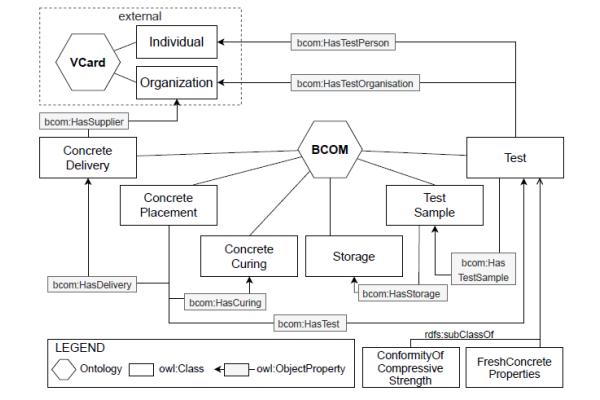28.06.2021

Liu Liu has been a research assistant at the chair since March 2020. She studied civil engineering at the Technical University of Cologne. She then went into practice and later studied civil engineering at the RUB in parallel in the master's program. Today she is a member of the projects AMSFREE and BIM4AMS. Furthermore, together with Philipp Hagedorn, she has developed a Building Concrete Monitoring (BCOM) ontology for construction.
An ontology is a system that represents concepts and the existing relationships between them. With the help of ontologies, data can be captured and linked in a machine-readable manner. Furthermore, the structured information can be managed and queried with regard to specific logic definitions, whereby a cross-domain data integration is achieved.
When it comes to the creation of concrete components, especially the process of concreting, there are many details to consider and document. The application of the ontology has now created a reference process for better digital recording of the operation.
The basic idea for creating the ontology is based on the initial situation that there is a BIM model, and a large amount of non-machine readable data - mostly in paper form. This data has a great importance for the construction process, but it is not actively linked to the building model. The recording and exchange of relevant information is an important part of the construction process. Depending on the technical requirements, quantity measurements, construction logs, delivery bills, photographs, inspection records, etc. are needed for acceptance and billing of the construction work. This information is recorded by the contractor during construction and handed over to the construction supervisor or the client. With the help of the Building Concrete Monitoring (BCOM) ontology, the important parts of this data for the process of concreting can be captured as semantic information, i.e. represented in a way that can be used and processed by a computer.
The current working method on the construction site can thus be further digitized and the data can be tracked more easily. For example, extensive documentation is constantly kept on the construction site when concrete is poured. Influencing factors such as weather, humidity, curing, type and quality of concrete are very important for the further life of the structure. When cracks or spalling occur over time, the information collected from the formation process can provide insight into why this damage occurs. In addition to this tracking, the assignment of this information in the BIM model is greatly simplified. This provides a good basis for the visualizable structural data in the operational phase.
Liu Liu: https://www.inf.bi.ruhr-uni-bochum.de/iib/lehrstuhl/mitarbeiter/liu_liu.html.de
Liu Liu has been a research assistant at the chair since March 2020. She studied civil engineering at the Technical University of Cologne. She then went into practice and later studied civil engineering at the RUB in parallel in the master's program. Today she is a member of the projects AMSFREE and BIM4AMS. Furthermore, together with Philipp Hagedorn, she has developed a Building Concrete Monitoring (BCOM) ontology for construction.
An ontology is a system that represents concepts and the existing relationships between them. With the help of ontologies, data can be captured and linked in a machine-readable manner. Furthermore, the structured information can be managed and queried with regard to specific logic definitions, whereby a cross-domain data integration is achieved.
When it comes to the creation of concrete components, especially the process of concreting, there are many details to consider and document. The application of the ontology has now created a reference process for better digital recording of the operation.
The basic idea for creating the ontology is based on the initial situation that there is a BIM model, and a large amount of non-machine readable data - mostly in paper form. This data has a great importance for the construction process, but it is not actively linked to the building model. The recording and exchange of relevant information is an important part of the construction process. Depending on the technical requirements, quantity measurements, construction logs, delivery bills, photographs, inspection records, etc. are needed for acceptance and billing of the construction work. This information is recorded by the contractor during construction and handed over to the construction supervisor or the client. With the help of the Building Concrete Monitoring (BCOM) ontology, the important parts of this data for the process of concreting can be captured as semantic information, i.e. represented in a way that can be used and processed by a computer.
The current working method on the construction site can thus be further digitized and the data can be tracked more easily. For example, extensive documentation is constantly kept on the construction site when concrete is poured. Influencing factors such as weather, humidity, curing, type and quality of concrete are very important for the further life of the structure. When cracks or spalling occur over time, the information collected from the formation process can provide insight into why this damage occurs. In addition to this tracking, the assignment of this information in the BIM model is greatly simplified. This provides a good basis for the visualizable structural data in the operational phase.
Liu Liu: https://www.inf.bi.ruhr-uni-bochum.de/iib/lehrstuhl/mitarbeiter/liu_liu.html.de